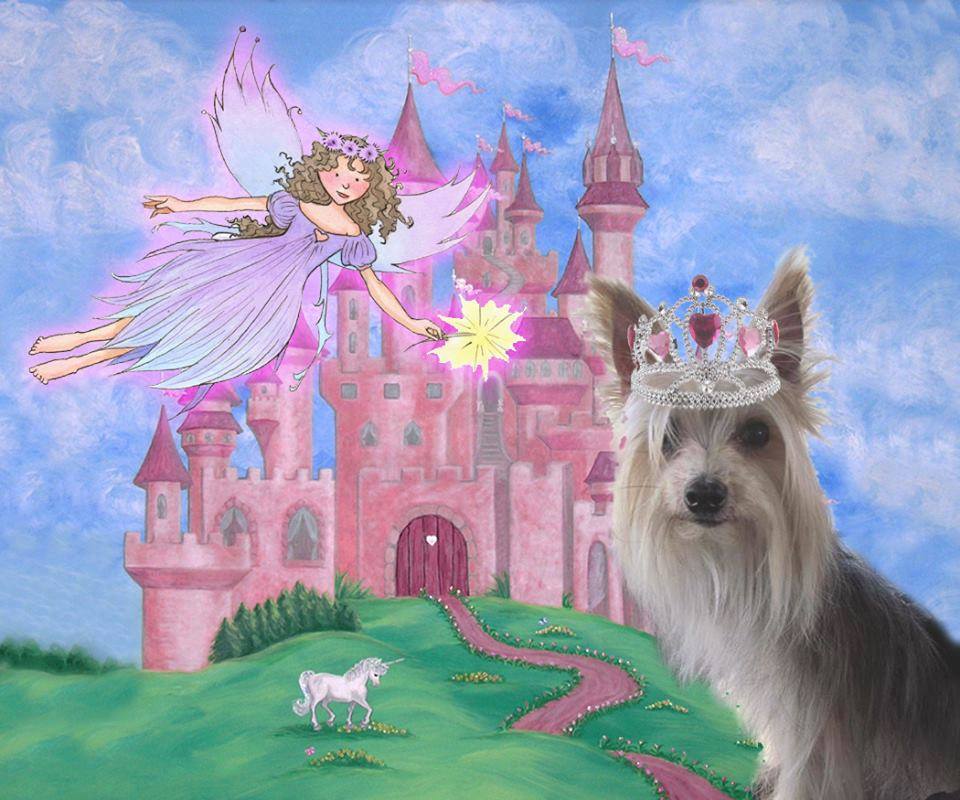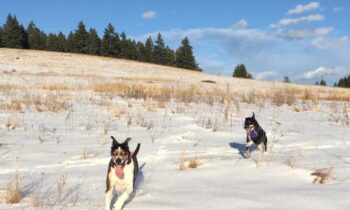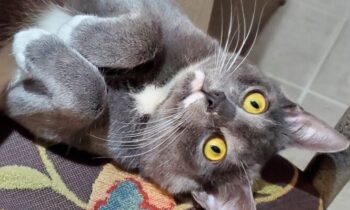


Last fall, I wrote about my oldest dog ever, who’s going on 19 now. She’s still alive! I don’t imagine she will last forever, but so far, so good. Her sight and hearing have continued to deteriorate. I think she’s almost completely blind: even bright light doesn’t help. I know she has some hearing left—at least, whatever might pass for hearing at her age and size. Echolocation, maybe . . .
The changes come faster every day. This winter, she would go down the outside stairs to the back yard with my big dog, do her business in the shoveled snow and ice at the bottom of the steps, turn around and come back. Until the melt, the farthest from the steps she would go was a few feet.
When the weather warmed up and she was no longer peeing on a berm, that entire habit pattern—of many years—changed literally overnight. She no longer came back up the steps to wait by the door with the big dog. He would be there, but she stayed in the yard, on the grass, walking around or standing, shaking. From that day, I have worn shoes instead of slippers when it’s time for her to go out, because it’s my job now to head down the stairs and out into the yard to retrieve her myself.
I carry her up the outside stairs, through the screened porch, and into the kitchen, where I set her down directly in front of her food bowl. In the morning, she gets two soft treats, broken up; in the evening, warm soaked kibble. Fortunately, she is as enthusiastic about eating as she always has been—very! She’s a tiny dog, about five pounds, who never turns down a treat.
Grooming
My little dog is no longer the glamorous long-haired show-stopper that she once was. I’ve trimmed more and more as the ends of her fur twisted together and turned into matted strands. It’s too painful for her to try to comb her thoroughly, as I once was able to do with no objection from her. Instead, I cut the twisted ends off up above the mats; there is long hair left, but only if it isn’t matted. I’m not the best at trimming evenly from one side of the dog to the other, but I’m getting better with practice.
My goal at this point is comfort (for her) and cleanliness (for us both).
I am struggling to keep up with both her fur and her nails in the short sessions that are all she can tolerate—especially now, since my big dog has a heavy coat and needs endless combing this time of year. I try to “do” a few minutes on the small dog right before I take her down to go outside. I cut one paw’s worth of nails, if I can manage, or trim the fur around one eye. Her underside I leave for when I know she’s empty; it’s a very important area for good hygiene but not her favorite spot for me to trim.
Her nails are important, too, for her mobility and especially for her safety on our hardwood floors and stairs. The longer the nails get, the less traction she has. Shorter is always better, but not easy to achieve. Her size helps there because I can hold her under one arm, upside down, paw sticking out, and trim those nails without her wiggling too much. That wouldn’t be possible on a much bigger dog or on a dog who wouldn’t easily accept being held like that for grooming. It’s something I’ve done with her all her life.
Her loss of vision has created one good change—in the bathtub. I bathe her in a clawfoot tub with a flexible shower attachment. I use a full-length no-slip bathmat. Until very recently, it was her habit to put her paws up on the high sides of the tub while I rinsed her. It was convenient for getting her underside hosed off well, but it had a downside in that she did slip every now and then, luckily with no injury ever . . . but she’s pushing 19: I shouldn’t be taking any chances with her health and safety.
When I bathed her last week, she didn’t put her paws up on the side of the tub at all—not once; didn’t even try. I can only speculate that she didn’t “paws up” because she can no longer see the sides of the tub! That was certainly not a development that I would have predicted. But it’s good!


Elimination
I’d wondered how winter would go for her. She’s not a fan of ice and snow; she never has been. She has for many years stalled out a few steps from the bottom when the ice and snow was thick, especially if I hadn’t shoveled or chipped enough cold substrate out of the way!
She’d peed on the screened porch on the way to the back door enough times last fall that I was starting to worry it would be our potty scenario for winter. That got turned around when I had to start carrying down the stairs from the second floor. I held onto her until we got to the back door, where I set her down at the top of the stairs so she could go outside. There hasn’t been a pee on the back porch since then!
She peed on my bed one night.
She’s slept on a potty pad in a kennel every night since then. Fortunately, our cat was right there when she peed, and the cat “notified” me of it within seconds, before any damage was done! She’s on the bed during the day, choosing to sleep primarily in a large pet bed that’s easy for her to find when I set her down. No leakage so far. When and if? Potty pads and/or diapers, as convenient.
She has full control of her bowels!
I’ve stuck to only food treats that I know her system can handle, in moderation. I gave her pumpkin for a few days when she seemed to be straining to poop, but only a tiny bit, and she’s been regular since. She gets a few O’s of Trader Joe’s cereal when I eat breakfast. I drop them on or near her feet and, although they do roll away a bit, it seems to be easy for her to sniff them out and scarf them up!
Safety
She Can’t Go Safely Down Inside Stairs!
I have to carry her. I am glad to say that she’s used to being carried. It’s never bothered her and I’ve always reinforced calm, accepting behavior—no wiggling or flinging herself around. That means it’s not difficult to carry her safely, but remember, she weighs only about five pounds. I have carried a cooperative 20-pound dog up and down the same stairs and I can tell you, it is not at all the same.
Five pounds of dog is easy to carry; 20 pounds of dog is not. Your mileage may vary, but don’t expect to be carrying your 40- or 50-pound dog easily up and down stairs when he gets older, unless you’re a body-builder type with super strength and you’re able to stay that way. Figure out another more practical plan, while your dog’s still young and mobile, and start training for it right now.
She Gets Lost in Most Familiar Places!
It would be funny if it weren’t so sad. I thought she would be able to use her nose and general familiarity with her surroundings to navigate. Nope! I know the standard advice, don’t move the furniture. Not only have I not moved the furniture since she got here 16-plus years ago, I have not moved the walls! Yet there she goes, every day, walking with what looks like strong intention, straight into a corner instead of through an open door. At first, I found it frustrating. I’ve come to accept it.
I can “herd” her gently with my feet, mostly just putting a foot in her way so that she turns in another direction. I’m getting good at gently touching her shoulder with the toe of my shoe. I’m anticipating her path because she goes in most of the same places every time she’s in a room—the wrong places!
A smaller dog must have an advantage in these situations. I watch her walk into a wall and think, She’s so small and so slow, it doesn’t faze her, when a bigger dog, a faster dog, would end up bashing his head into that wall, maybe leaving a dent. There are headpieces for blind dogs to wear that warn them of a solid object in their path before they hit it. I don’t think my dog needs such a piece of equipment because she’s not hurting herself, but if you have a bigger dog who’s likely to lose vision, check out the adaptive devices that are available. And, again, start training now, while he can see.
She “Forgets” How to Climb the Stairs!
This is worse than her getting lost in the kitchen. Not only does she seem to forget how to climb the stairs, she seems to forget where the stairs are! I follow her across the front hall, direct her with a toe-touch or two to the bottom of the first stair—up just one, to a landing. Then there are many stairs up to another landing, then a change of direction and up some more stairs to the top.
She stalls out before she makes it to the first landing, one step up.
I have found, in this last week, one thing that seems to help. I am not sure at all why it helps because, in theory, she is almost completely deaf. I know she is unable to orient to my voice either outside or inside, so of course I can no longer call her or encourage her to come when she is called. In my front hall, though, and on my inside stairs, she does seem to know (I won’t say hear) when I yell “Hup!” in a very loud voice. “Hup!” is the cue I use for all my pets to mean “jump up” on something, like the bed. Even the cat knows that cue: she jumps up to the top of the fridge where her food is.
I think, and it’s my best guess, that the acoustics of the hallway and stairs are helping us immensely with this exercise. My little dog may not hear my voice, per se; she may be feeling the vibrations of my voice instead, due to the particular location’s physical properties. In short, it’s echo-y there.
I can’t explain it with certainty. It could be just a fluke. It could be like everything else I thought I’d figured out about my little dog as she’s been aging: it could change tomorrow. My insights into her behavior seem to have a short shelf life. I’ve no sooner got one weird behavior sorted out than it changes—overnight. I am so lucky that, at this moment, she may be deaf and blind but other than a little stiffness, she’s in good health, continent when awake, eating eagerly, and sleeping well.
That can all change in a second.



